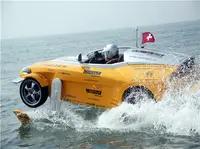Rinspeed Splash 'Hydrofoil Car' Sets New English Channel Crossing Record - VIDEO ENHANCED STORY
Edited by Marc J. Rauch, Exec. VP/Co-Publisher
DOVER, England - July 27, 2006:
 |
Whereas "normal" amphibious cars displace the water like a boat and therefore bear some resemblance to a bathtub, the "Splash" skims over the water on extendable wings like a hydrofoil. "We crossed the busiest waterway in the world as if on a surfboard," said Rinderknecht.
To make the voyage the original "Splash" had to be converted to an offshore-capable version.
 |
• Watch a great 7 min. video of the original "Splash" car, complete with underwater shots and real-live mermaids from Weeki Watchee Springs in Florida.
The successful record ride over the waves was a tough ordeal not only for the pilot but also for the material.
 |
In theory, the 36 km or so between Dover and Sangatte would have taken just under half an hour but, says Rinderknecht, “I may be able to drive at that speed at home in Switzerland on Lake Zurich with no wind and the surface as smooth as glass, but not on one of the most difficult stretches of water in the world. But safety was always the prime concern.”
With his arrival at the French town of Sangatte, he captured his entry in the Guinness Book of Records. Frank M. Rinderknecht was overjoyed: “We Swiss are not just good at making the tastiest chocolate; we can also build the fastest hydrofoil vehicle in the world – even though we’re not exactly a seafaring nation …”



